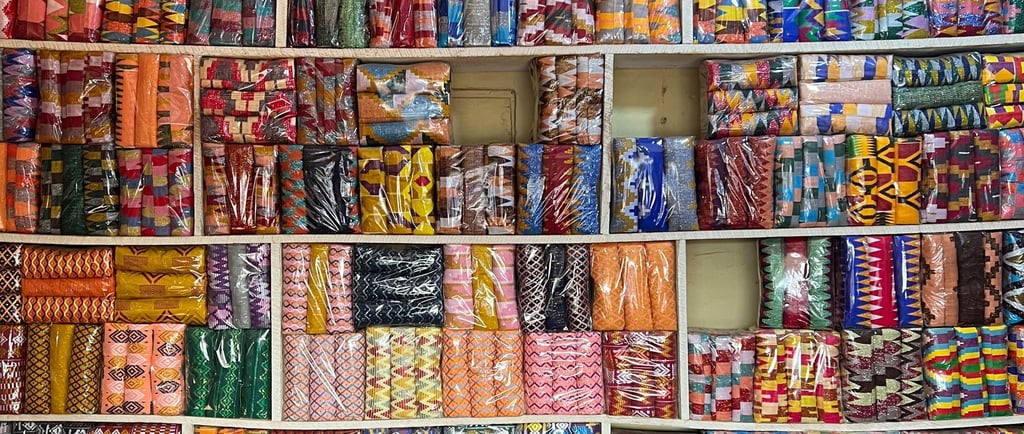The Significance of Kente Cloth from Kumasi, Ghana: Origins, History, and Legacy
The origins of Kente cloth are deeply rooted in the cultural and historical fabric of Kumasi, Ghana, often referred to as the heart of the Ashanti kingdom.
CULTURE
Leslie E. Jones
5/29/20244 min read


Origins of Kente Cloth
The origins of Kente cloth are deeply rooted in the cultural and historical fabric of Kumasi, Ghana, often referred to as the heart of the Ashanti kingdom. The creation of Kente is steeped in rich traditional stories and myths that have been passed down through generations.
One popular legend tells of two brothers, Kurugu and Ameyaw, who were inspired by the intricate patterns of a spider's web. Observing the spider's weaving techniques, they learned to create their own complex designs using natural fibers.
I was able to interview the Chairman of Kente Cloth: Stephen Amofa during my visit to Kumasi, Ghana. Check it out!
Initially, Kente cloth was woven using raffia fibers, which were readily available in the region. Over time, the material evolved with the introduction of silk, which was traded through trans-Saharan routes.
The transition to silk not only enhanced the aesthetic appeal of Kente but also signified a shift towards a more luxurious textile, reserved for royalty and special occasions. The Ashanti people, known for their rich cultural heritage, played a pivotal role in developing Kente weaving into an art form that symbolizes their identity and values.
Geographically, Kumasi's strategic position made it a vital center for trade and cultural exchange, further enriching the Kente weaving tradition. The Ashanti kingdom, with Kumasi at its core, became a hub for artisans and weavers who perfected their craft, passing down techniques and patterns that have remained largely unchanged for centuries.
The intricate designs and vibrant colors of Kente cloth are not merely decorative but carry significant meanings. Often representing proverbs, historical events, and social status.Thus, the origins of Kente cloth are a testament to the Ashanti people's resilience, creativity, and cultural pride.
Through the centuries, Kente has transcended its initial function as a utilitarian fabric to become a symbol of Ghanaian heritage and identity. Celebrated both locally and internationally.The historical significance of Kente cloth from Kumasi, Ghana, is deeply intertwined with the cultural and social fabric of Ashanti society.
Traditionally, Kente was not just a piece of fabric but a symbol of royalty and high status. It was predominantly worn by kings, queens, and important figures during significant ceremonies such as enstoolment, weddings, and funerals.
The intricate patterns and vibrant colors of Kente cloth each convey unique meanings. Adding layers of depth to its cultural importance. The patterns and colors used in Kente cloth are rich with symbolic meanings.
For instance, black is often associated with maturity and spiritual energy, while gold signifies wealth, royalty, and high status. Other colors like blue symbolize peace and harmony. Green represents growth and renewal.
The intricate designs themselves often tell stories or convey proverbs. Making each piece of Kente a visual narrative that reflects the values and history of the Ashanti people. The craft of Kente weaving is an art form that has been passed down through generations with each weaver contributing to the evolution of its techniques and designs.
Traditionally, the weaving process was labor-intensive and required skilled artisans who could create complex patterns on narrow looms. Over time, the methods have adapted to incorporate new materials and techniques, making the craft more accessible while preserving its essence.
This evolution has allowed Kente cloth to maintain its relevance in contemporary society while retaining its traditional significance. I got the chance to record them in motion during my visit to Bonwire. The headquarters where the Kente Cloth is made. Check it out!
Furthermore, the global reach and influence of Kente cloth cannot be understated. Its distinctive patterns and bold colors have captured the attention of notable figures worldwide, from political leaders to celebrities.
These endorsements have elevated the status of Kente cloth. Turning it into a symbol of African heritage and pride on international platforms. As a result, Kente has transcended its origins to become a global icon of cultural identity and artistic excellence.
The Legacy of Kente Cloth
Kente cloth, originating from Kumasi, Ghana, holds a profound legacy that extends far beyond its historical roots. In contemporary society, it serves as a powerful symbol of cultural pride and heritage, particularly within African diasporic communities.
The vibrant patterns and intricate designs of Kente cloth are not just aesthetic expressions. They are embodiments of identity, storytelling, and a deep connection to African ancestry.Today, Kente cloth continues to make significant impacts in various realms, including fashion, art, and design.
It has been embraced by modern fashion designers who incorporate its distinctive motifs into their creations, thereby introducing the rich cultural tapestry of Ghana to a global audience. In the realm of art, Kente cloth patterns inspire countless works, underscoring the cloth's influence beyond its traditional uses.
The versatility of Kente cloth is further evident in its utilization in contemporary home décor and accessories, which blend traditional African aesthetics with modern sensibilities. Moreover, Kente cloth maintains a prominent presence in significant life events and ceremonies.
Graduations, weddings, and political ceremonies frequently feature the cloth. Underscoring its role as a marker of importance and respect. During these occasions, wearing or displaying Kente cloth signifies a connection to heritage, accomplishment, and communal values.
Despite its enduring prominence, the traditional methods of Kente weaving face challenges. Artisans who dedicate their lives to this craft often struggle with issues such as economic pressures and the influx of mass-produced imitations.
Efforts to preserve the authenticity of Kente weaving are crucial, as they ensure that the intricate skills and knowledge passed down through generations are not lost. Supporting these artisans and promoting authentic Kente cloth are essential steps in maintaining this cultural treasure.
Check out the tour Chairman Amofa gave me of the Export Production Village.
In a broader context, Kente cloth's influence on global culture is undeniable. It promotes African identity and unity. Fostering a sense of pride and connection among people of African descent worldwide.
The legacy of Kente cloth is a testament to the enduring power of cultural heritage and its ability to transcend borders, touching lives across the globe. Check out what I did with my Kente Cloth!
Not going to Ghana but want your own Kente piece as home decor? Click here for my Store!
Want a curated trip to the Motherland? Click here for my tour company recommendation!
Join Us!
Are you looking for a traveling community? Join our "Small But Mighty" Crew Facebook Group! We're all about sharing, helping, and learning together through travel which was birthed from my YouTube Channel. This is a safe space to share your travels and stay updated on my next adventures. Let's make some memories together!






